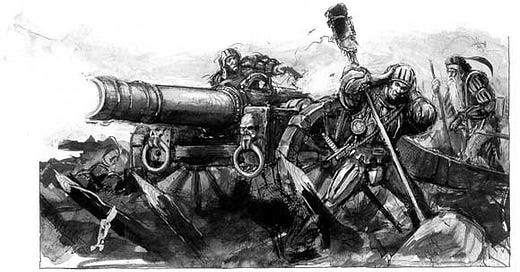In the past, I’ve written extensively about the inclusion of black powder arms in fantasy worlds. It’s something I’ve given a lot of thought to as I’ve built up my setting of Nighthaven which includes black powder weapons. Whenever we look at exploring fantasy with a slightly elevated technological level though, there’s always a question of what role magic plays. Does technology oppose magic? Is magic the thing that’s driving the advancement of technology? Is there any any synergy between the magic and the technology? Today I’ll be discussing three possible relationships between technology and magic and what I think of each of them. Understanding how these two forces interact with each other can tell you a lot about your campaign world and meaning that these ideas are definitely worth thinking about.
Let’s begin with the idea that magic and technology are opposing forces. This idea mirrors the widely-held belief that what our ancestors viewed as acts of God or magic were actually scientific phenomena that we now understand. While I personally do not subscribe to this theory, I can see the hook of technology overtaking magic. This would be the kind of world where wizards are feared and persecuted or long-forgotten. Perhaps rediscovering magic and its use could be a central theme of the campaign. Maybe the magic is really technology, but a technology that is long-forgotten like in Mutant Crawl Classics. There are plenty of interesting permutations of this idea that would be worth looking into. for now though, we should move on to the next version of the relationship between technology and magic.
In our second conception, we have the idea that magic is the cause of the advance in technology. There’s essentially no distinction between magic and technology in this version. Magic acts as a replacement for electricity, combustion, nuclear fission, etc. I must admit that I am not a big fan of this concept. I’ve played around with it in the past, but the result is the kind of pseudo-steam punk style of fantasy that you can see in something like Eberron. When people talk about fantasy elements being eclipsed by the introduction of post-renaissance technology to a campaign world, I think this is what people are thinking of. These kinds of campaigns quickly turn from fantasy to science fiction. Not space fantasy either, just straight-up science fiction. Some people do seem to enjoy this kind of magical technology, including several friends of mine, but I personally don’t like it.
The last version of the magic/technology relationship is probably my favorite. In this iteration, there is magic and there is technology. They simply coexist with each other. Sure, there’s some crossover. A mage might enchant a gun or create some kind of magical device, but there’s enough separation between magic and technology that one doesn’t trample the other. The thing I like about this relationship is that it allows for the most freedom for players and GMs to determine the relationship. Maybe a player wants to be a wizard that studies technology. Maybe the party encounters a church that seeks to destroy technology. While the other concepts have their hooks, this is the one that allows both magic and technology to flourish in their own ways.
Playing around with magic and technology being either opposing or complimentary forces can change a campaign world drastically. However, the most freeing way to keep both in your world and not have them hurt each other is to let them exist in parallel without directly effecting each other. The inability to keep both in balance in your campaign world often results in certain players feeling alienated as the thing they prefer gets minimized by the dominance of the other. While it can be interesting to mess with the dynamic, it’s ultimately best to keep them as separate but coexisting forces.




